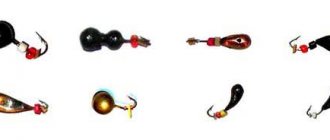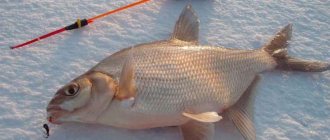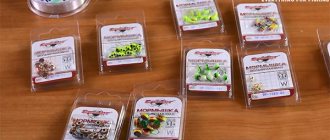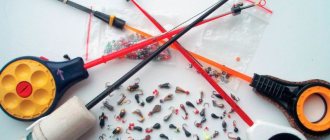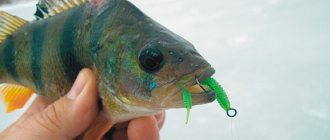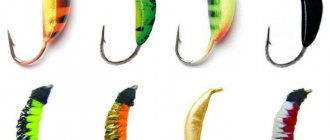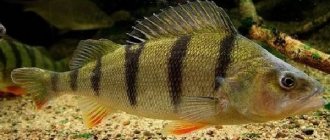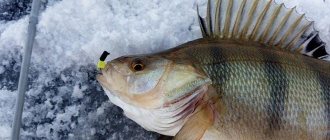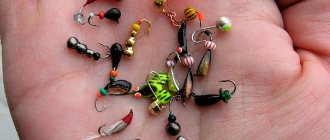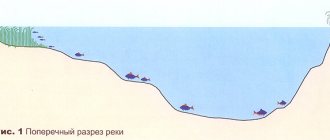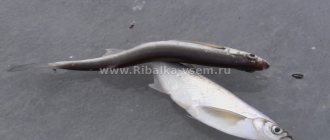Principles of reelless gear
It is clear that the percentage of anglers who use bloodworms, amphipods, worms, maggots, goosefish or any other bait when fishing is greater than those who make do with only a few beads on the hook. After all, almost all novice winter fishermen gain experience while fishing with bait - this, one might say, is the traditional way of fishing in winter. In addition, it is simpler and more understandable for a novice fisherman. And the “roll call” with summer is obvious here - you can throw the tackle and wait for a bite, looking at the nod. But over time, many people want to go further in fishing, learn something new, master more complex techniques and methods of fishing.
The whole point of reelless fishing is to imitate the life of an insect or other underwater inhabitant. In other words, if in bait fishing a fish can react to a bloodworm or a worm on a hook even in a static position, then in baitless fishing a stationary jig will not interest anyone. Thus, only playing with bait, a creative search for combinations and wiring options can bring a stable result to the angler without a reel. And the parallel with spinning or fly fishing is obvious here - only the attractive movement of the bait and the skill of the fisherman can lead to a bite.
There are many options for wiring a jig. It’s enough to imagine how many mathematical combinations can be made from just 4-5 digits, just by swapping them and putting them in pairs and triplets. The same here: frequency, amplitude, speed, direction, type of jig and suspension, fishing horizon, etc. With experience comes an understanding of which combinations work best in a particular body of water, for a particular fish. It’s only difficult at first - you just need to believe in the catchability of a naked jig.
The entire tackle, its structure and components depend on the game that needs to be created (and again, like in a spinning rod). Everything, from the fishing rod to the nod, is strictly subject to the requirement - the jig must play as intended in its design or as the angler wants. The main mistake of beginning reelless jigs (especially “devils”) is inattention to gear and overly high hopes placed on reelless jigs. Let's look at several of the most common options for equipping reelless fishing rods.
Jig fishing technique
The earring test was carried out over a month on different types of reservoirs. The jig showed good results on roach, bream, white bream, perch, ide, etc. The earring met the above requirements and, most importantly, in terms of catchability it left behind the classic reelless jigs, as well as devils and goats. It showed excellent performance on jigs suspended at 90˚ relative to the fishing line (reelless jigs practically don’t work in this case).
With different wiring, the beads make noise simply due to vibrations, which is also a definite plus and arouses the fish’s interest in the bait from a long distance. I repeat, an important point, especially for beginners, is that it is undemanding when it comes to wiring—a slight sway with a nod is enough, as when fishing with a bait.
Well, the master of a rewinder with an earring has a huge field of activity in various combinations of wiring. From the practice of fishing with an earring, it was noticed that the fish does not lose interest in the bait for a long time and, even when it falls off the hook, attacks the bait again. The only thing that needs to be taken into account is that when biting, the hook should not be done immediately, but with a pause, because The suspension has a volume comparable to an animal bait, and often the fish is not able to swallow the bait entirely.
Based on the last ice, I chose the color “white wing + red beads” not by chance, because... Closer to spring, fish, especially bream, in our area prefer a “sandwich” of maggots and bloodworms. And I devoted my last fishing trips from ice to catching bream with an earring. The devil was “resting”! The “earring” jig simply mowed down both the small underbreeder and the fish that did not fit into the hole. At the very end of the season, a trophy bream was caught on a new jig - 2100 grams. I advise you to try to make an “earring” jig with your own hands and I think that you will believe in it and will definitely not be left without fish!
Reelless gear equipment
“Small” baitless fishing often requires a completely different approach to design and equipment than, for example, fishing with a “devil” or “jellyfish”. Most of the time this is really shallow (i.e. shallow water) fishing. And if the “jellyfish” can be safely driven to at least a 20-meter depth, then a small nozzle will hardly be able to swing normally even at a depth of 4-5 m. Of course, there are also heavier jigs like the “Ural” one, which easily reach a horizon of 4 -5 m, but even their play at such a depth becomes less expressive and unnoticeable. Line friction, water pressure, etc. greatly hinder the play of the bait, and this should be remembered.
Reelless fishing rod
And at depths of about 3 m, the nozzle is the real queen of the water. There are several main types of fishing rods for “correct” baitless fishing. And the first among them, of course, is the classic “balalaika”. It’s not easy to find a good (and most importantly, lightweight) foam “balalaika.” Even if there is a fishing rod made of hard foam on sale, it is prohibitively large and rough. And you have to arm yourself with a knife and sandpaper to put it in order.
You can choose from several options for the balalaika whip, but even here you always have to remember about the weight. Thin and elastic carbon (the most sensitive) can be too fast for thin lines, and when biting large perch, breaks may occur when hooking. Although both weight and sensitivity will be at their best. If you use plastic, you will have to look for the best option.
Nod to the rewinder
Now about the nods. Nods for a “small” reelless jig are a very specific thing, one might say, individual for each jig. Now the vast majority of such nods are made of lavsan. But it is simply impossible to purchase a decent nod for baitless jigs in a store. Those that are on sale have a cone in only one plane - in width. And even if the design includes another backing plate to make the cone thicker, it turns out to be too rough and heavy. The angler is simply forced to make a good nod for a nozzle himself. And this is especially true in perch fishing, because this fish is very partial to high-frequency vibrations of the bait, and they can only be achieved with a nod correctly selected for the jig.
Such a nod can work in two versions: straight and inverted, turning into a “snot”. The first option allows you to create several ways of high-frequency playing, mainly the most “playing” part is the last 1/3 of the total length. You can create high-frequency play in different ranges and smoother swings. If the device is turned 180° around the axis of the whip, it turns into a “nozzle”: the bend increases to 70-80° and only the tip of the nod works. In this way, the highest frequency vibrations can be achieved.
Features of jigs and pendants for perch
The jig, whatever it is, should not occupy a horizontal position in the water column. A jig hanging with such a “dead” weight practically does not play. This is especially true for perch, a fan of high-frequency, high-speed game. The hook of the jig should be directed downwards at an angle of up to 45°. In this case, even with a pendant made of one small bead, the bait will easily fall out of balance and oscillate in two planes - horizontal and vertical. Often it is this mistake that makes beginners without moths refuse to master such an exciting method. The classic “pellet” is a bad option for nozzle.
If we talk about a specific model of jig for no attachment, we should name “Ural”, “droplet”, “cobra”, “clove”, “banana”, “ant”. The very appearance of such jigs clearly shows their capabilities in the water. The hook is always slightly lowered. It is important to note that tungsten, for all its advantages, is much more difficult to swing than lead, so you should choose tungsten jigs with caution.
At the same time, the play of the jig can change greatly depending on the movements of the angler and the characteristics of the nod. You can highlight one aspect of the game and neutralize another. And vice versa.
Pendants for nozzle jigs
Various pendants on the hook (beads, cambric, silicone, polyurethane foam, etc.) are primarily intended to create the correct game and only then to attract fish. Beads are the most popular, and this is not surprising. It has enough weight to swing a jig, has a ringing sound during play (there are dull and ringing beads), and is available in a huge number of colors and sizes. In addition to beads, you can use many other materials to equip and configure the jig: pieces, tails or balls made of silicone, polyurethane foam, plastic beads, and various combined pendants. If you use all this correctly, the bait will begin to sparkle and bites will not take long to arrive.
Making jig “Earring”
To make the winter jig “Earring” with our own hands, we will need cambrics of different colors, beads and Super Moment glue. We take an ordinary cambric of the desired color, preferably thin-walled (you can buy a set at the same fishing store). We cut off a piece of cambric with scissors, and then cut it lengthwise. We straighten the workpiece and cut out a washer-wing of the required size using a punch tube.
I used an old radio antenna and sharpened the cutting edge with a file. Then we cut narrow strips from the same cambric and insert them into the beads. Next, we glue the strips to the puck with “Super-moment”. We wait for the glue to dry and make an internal hole (I used a thick medical needle). We finally remove all the excess, and the earring is ready. Of course, the method of making a jig can be completely different, I just offered my own version.
Before installing the earring link on the hook, we test it for tearing by lightly pulling the beads with our fingers. Thus, we eliminate the weak links in advance. In the process of fishing, not a single link of the earring has yet scattered when the hook was pulled out. I would like to draw your attention to the fact that when moving from hole to hole and lowering the jig into the water, you must make sure that the suspension elements are not frozen, otherwise the game will not work. This applies to all reelless jigs with hanging elements on the hook - beads, cambric...
It can be treated by simply warming it with your fingers. Nuances. The optimal ratio of the weight of the beads to the resistance of the wing will be such that even with the slightest movement of the nod, the earring “winds up with half a turn.” Theoretically, I can’t imagine how to calculate this, so far it can only be done experimentally. We install one link on the hook, take the jig with our fingers, even a motionless hand still transmits micro-vibrations, and the earring link should “tremble” at the same time. Various options (double, triple) for equipping jigs, both classic and devil, jellyfish with the “earring” element are shown in the photo. You can also equip them with a pendant - a single hook above the jig.
Catching combinations for perch
- "Descent/ascent". We begin fishing a fresh hole with a smooth descent of the jig from top to bottom. In this case, the game can be either high-frequency or practically none - smooth swaying, for example. At this stage, the main thing is not to scare the fish with unnecessary movements, just check the hole for the presence of fish. After descending to the bottom, almost without pauses, we begin lifting the bait. Here you can also get by with smooth rocking or lifting without playing at all. We repeat the cycle about 3-5 times. If there are no bites, then we either change the hole or start another playing combination.
- Hitting the bottom. For 2-3 minutes we simply methodically tap the bait on the bottom. This, at first glance, is a rather boring process, but it is this wiring that sometimes brings the biggest perches. It’s impossible not to notice the similarities with fishing on a bullhead, only here we don’t throw the bait, but tap it on the ground for a long time, raising clouds of turbidity. If there are no bites, raise the bait 3 cm above the bottom and wait for about 10 seconds. Next, slowly, but with a high frequency of oscillations, we begin to lift the jig to an outstretched arm. At the end of the transaction there is a pause of 10 seconds. Reset. The higher the frequency and lower the rate of rise, the better. In contrast to the first retrieve, when no action was given to the bait, such a sharp increase in frequency very often works. About 70% of bites occur during a pause after long strikes on the bottom.
- "Drowning booger." We raise the hand with the fishing rod as much as possible and begin lowering the bait with a constant blow of the finger on the whip - in this case the bait jumps and falls again. Ideally, the bait should move as if trying to surface, but still periodically breaks down. She went up a little, but fell 5-10 cm down, froze, gathered the strength to jerk (she was shaking all over), but went down again. This attracts fish, because the jig looks like a helpless victim, unsuccessfully trying to escape.
- "Contrast". One of the most catchy fishing for any fish, and especially for a very curious perch. We start the descent at high frequency from above and lower the bait to the very bottom. After touching the bottom, we abruptly change the game without pausing. You can start swinging the jig smoothly, you can simply change the amplitude and frequency by an order of magnitude, you can start hitting the bait on the bottom. The main thing is to create the most contrasting effect, which is difficult not to notice. The same method has proven itself to be excellent in the following version: we make 3 identical lifts of the jig with a strictly specified amplitude and frequency, but on the fourth lift we sharply change the game, but maintain the speed of the retrieve or change it, leaving the same characteristics of the game. This works great for passive or wary fish.
Playing technique
A reelless jig for perch must not only be selected correctly, but also served well to the striped fish. Over time, each angler develops his own unique game, producing certain nuances of automatic fishing. Let's look at the basic techniques of combinations of reelless fishing for perch.
- Base – dotted or even rises and falls. The frequency and amplitude are selected on the reservoir.
- Perch loves mud. Therefore, it is always useful to tap the bottom a little with a reelless bait and pause, raising the bait 3-5 cm.
- You should always pause at the top point of any retrieve - this is where bites often occur. The duration of pauses can be different, we are looking for the right one.
- Frequent fluctuations in one place.
- Fast rises and drops.
- Lifting gear with acceleration.
In the dead of winter, fish are inhibited and metabolism is slowed down. Perch most likely will not attack a bait that is too active, saving energy and calories. The entire underwater world lives in energy saving mode at this time. The technique of playing for a passive predator requires a sluggish one, with long pauses, allowing the perch to slowly approach and take the bait without much effort:
- Slow rocking and movements;
- Monotonous swotting with a reelless reel in one place (to drive the fish out of patience);
- Walking and pulling along the bottom (possible with a clear bottom, wide hole and shallow depth);
- An abrupt change in the type of game, amplitude or frequency (without a pause).
Catching a striped pirate with a reelless jig is always an experiment. Every time, especially after a change in the weather, the angler needs to look for something new, select the most catchy jig or method of play today.
